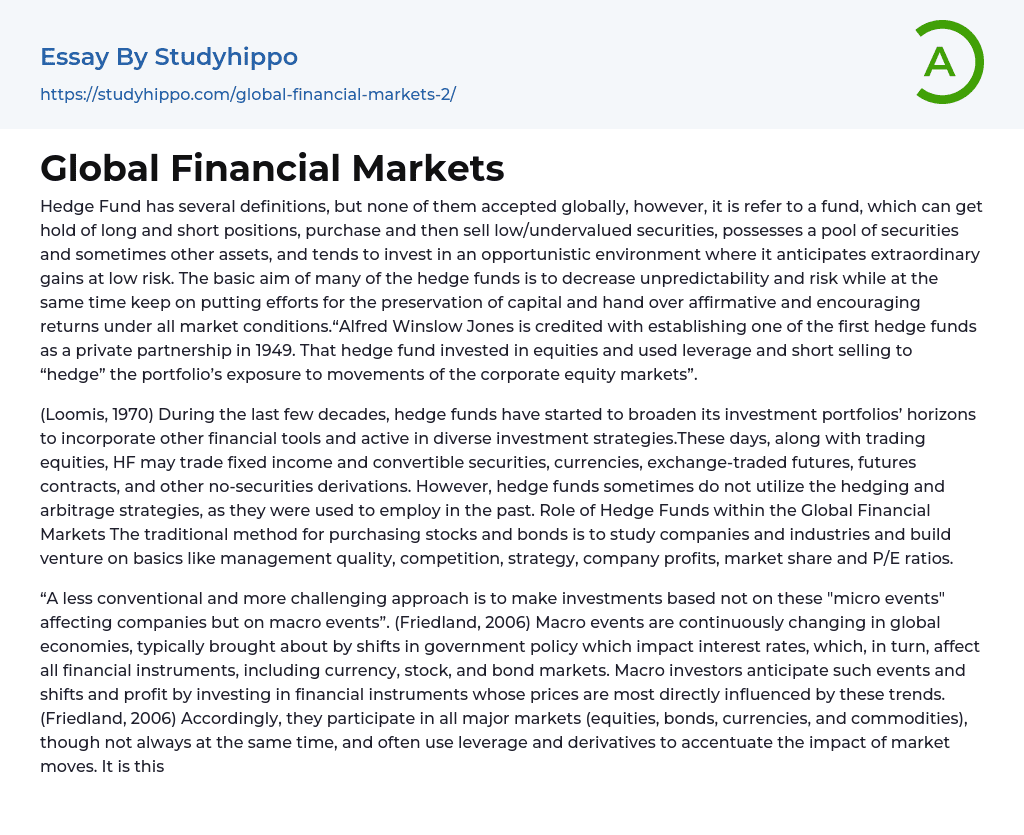Although there is no universally accepted definition of Hedge Fund, it generally refers to a type of fund that utilizes long and short positions, buys undervalued securities and sells them at a higher price, has a variety of securities and sometimes other assets, and tends to invest in an opportunistic environment with the goal of achieving extraordinary gains at low risk. Many Hedge Funds aim to reduce unpredictability and risk while attempting to preserve capital and provide positive returns under all market conditions. In 1949, Alfred Winslow Jones established one of the earliest Hedge Funds as a private partnership that invested in equities, utilized leverage and short selling to hedge against movements in corporate equity markets.
(Loomis, 1970) In recent years, hedge funds have expanded their investment portfolios beyond equities and have become more engaged in diverse investment strategies. Hedge funds now trade fixed
...income and convertible securities, currencies, exchange-traded futures, futures contracts, and other non-securities derivatives. While hedge funds once utilized hedging and arbitrage strategies, they may not employ these tactics as frequently now. Hedge funds play a role in the global financial markets by deviating from traditional methods of purchasing stocks and bonds, instead focusing on analyzing companies and industries to make venture decisions based on management quality, competition, strategy, company profits, market share and P/E ratios.
According to Friedland (2006), a less conventional and more challenging investment approach is to focus on macro events instead of individual company "micro events". Macro events are constantly changing due to shifts in government policy, which affect interest rates and in turn, impact all financial instruments like currency, stock and bond markets. Macro investors anticipate these shift
and profit by investing in instruments that are most influenced by these trends. These investors participate in all major markets, leveraging and using derivatives to amplify market moves. However, this use of leverage on directional bets, which are often not hedged, can result in high volatility for some macro funds. As a result, macro investing is seen as a high-risk strategy.
According to Friedland (2006), the media tends to exaggerate how often well-known hedge fund managers experience significant losses. Despite using different approaches, macro hedge fund managers share some similarities in their investment strategies. These include investing in multiple sectors and trading instruments, as well as being opportunistic and responsive to shifts in economic policies, political climates, or interest rates. Hedge funds have the potential to generate positive returns even during falling equity and bond markets, making them advantageous for investors.
Investors can enhance their portfolio by including hedge funds, which can decrease risk and volatility while increasing returns. The broad range of available hedge fund strategies offers non-correlated options, enabling investors to choose a strategy that matches their investment objectives. Academic research has confirmed that when compared to conventional investment funds, hedge funds have lower risk and higher returns. Hedge funds are an excellent option for long-term investments as they remove the requirement for efficient market timing.
According to Friedland (2006), adding hedge funds to an investment portfolio provides diversification that is not offered in traditional investment methods. Hedge funds employ various hedging strategies, such as selling stocks without ownership, using arbitrage to take advantage of pricing inefficiencies between related securities, trading options or derivatives based on underlying financial assets, and investing in anticipation of
specific events like merger transactions, hostile takeovers, spin-offs, or exiting bankruptcy proceedings.
Investing in deeply discounted securities is a common practice among hedge funds, particularly those focused on companies in financial distress or bankruptcy. These securities are often valued below their liquidation value. Additionally, many hedge fund strategies benefit from being non-correlated to equity markets. As noted by Friedland (2006), the popular misconception that hedge funds are all volatile and rely heavily on global macro strategies with substantial directional bets and leverage is untrue. In reality, less than 5% of hedge funds operate as global macro funds.
In general, hedge funds prioritize an absolute return strategy that aims to generate profits across different market conditions. While some hedge funds may use derivatives for hedging purposes or not use them at all, many do not utilize leverage. Conversely, registered investment companies typically follow a relative return approach whereby they strive to match or outperform a specific asset class or securities index.
In the text, Carol Loomis discusses the difficulties faced by hedge funds in the 1970s, as noted in her article "Hard Times Come to Hedge Funds". Meanwhile, Dion Friedland speaks about global macro investing in his publication "Global Macro Investing" from Magnum Funds, available at http://www.magnum.com/hedgefunds/globalmacroinvesting.
- Investing essays
- Asset essays
- Depreciation essays
- Discounted Cash Flow essays
- Foreign Direct Investment essays
- Funds essays
- Internal Rate Of Return essays
- Revenue essays
- Day Trading essays
- Futures Trading essays
- Capital market essays
- Million essays
- Payment essays
- Rate Of Return essays
- Funding essays
- Hedge Fund essays
- Bank essays
- Banking essays
- Corporate Finance essays
- Credit Card essays
- Currency essays
- Debt essays
- Donation essays
- Enron Scandal essays
- Equity essays
- Financial Accounting essays
- Financial Crisis essays
- Financial News essays
- Financial Ratios essays
- Financial Services essays
- Forecasting essays
- Foreign Exchange Market essays
- Free Market essays
- Gold essays
- Investment essays
- Legacy essays
- Loan essays
- Market Segmentation essays
- Money essays
- Personal finance essays
- Purchasing essays
- Retirement essays
- Shareholder essays
- Stock Market essays
- Supply And Demand essays
- Venture Capital essays
- Accounting essays
- Andrew Carnegie essays
- Automation essays
- Business Cycle essays




